Many people are unaware of just how many different firearms were produced by the Hotchkiss company over the decades – not many of them received the worldwide acclaim of the more well known arms companies. Hotchkiss was actually founded by an American gunsmith from Connecticut, Benjamin Hotchkiss. Faced with the lack of interest in new arms development in the US during the Civil War, he moved to France and set up a factory (this movement to Europe to find interest in new arms was a common story for American gunmakers at the time). There he proceeded to develop a whole series of pretty successful machine gun designs, including the Hotchkiss Revolving Cannon, Hotchkiss Portative (adopted by the US as the M1909 Benet-Mercie), and the M1914 Hotchkiss heavy machine gun (standard issue for the French Army throughout WWI). This development continued after the end of World War I, and resulted in the M1922 Hotchkiss, a light machine gun made for export to anyone who was interested.
-1024x221.jpg)
The Hotchkiss M1922 was passed over by the French military in favor of the Chatellerault 24/29, and it was not adopted in large numbers by any other major military forces. Several smaller nations did purchase quantities of the gun, and this led to a lot of variations of it being made. Hotchkiss had a long history of exporting weapons, so they knew that flexibility was key to getting small contracts. The M1922 (also referred to as the M1924 and M1926) was available in virtually any rifle caliber a potential client might want, as well as with a variety of barrel types, front grips or handguards, bipods, and even with the option of being fed by strips or box magazines.
Strip Feed
The rigid metal feed strip was obsolete by the 1920s, but not everyone realized this, or cared. It was originally used with the M1914 Hotchkiss heavy MG, and also on the Portative, so it was natural that Hotchkiss would continue to use it. Obsolete or not, it was a proven system that people were familiar with. The short strips would hold 15 rounds, and longer ones held either 24 or 30, depending on the type of cartridge (cartridges like the 8mm Lebel with a rim and large taper were limited to 24 rounds, while more rimless and less tapered ones like the 7mm Mauser would hold 30 in approximately the same length of strip). The strip would be inserted cartridge-side-down into the right side of the gun, and was cycled through the action by an arm connected to the bolt (basically the same mechanism as a belt-fed weapon uses).
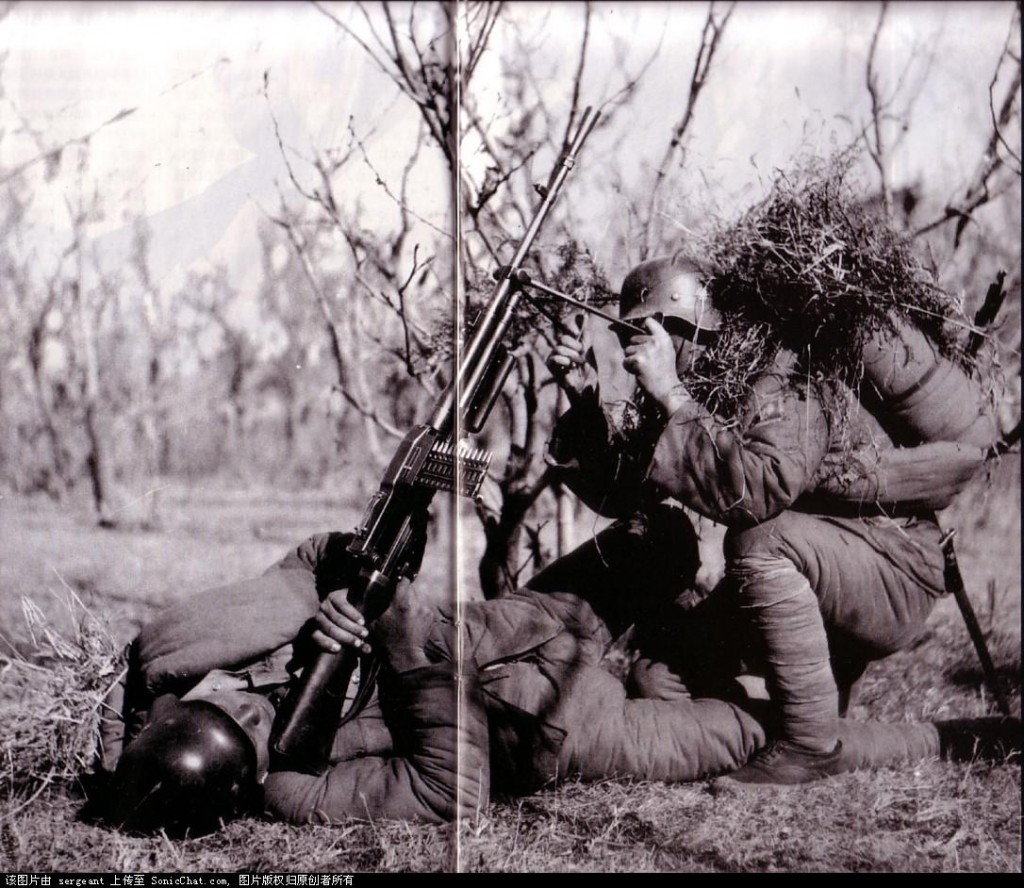
Guns set up for strip feed (which appears to have been the majority of these guns sold by Hotchkiss) has a flip-up top cover like a belt-fed gun, allowing access to the feed mechanism.
We have photos of a strip-fed Hotchkiss M1922 in .303 British that was tested by the UK government in the 1920s (courtesy UK MoD):
Box Magazine Feed
A more modern and simpler system was to feed a light machine gun such as the Hotchkiss with interchangeable box magazines. While magazines were bulkier and heavier than feed strips, they protected the cartridges from dirt much more effectively, and were generally more durable and less prone to damage than strips. The M1922 could be ordered using box magazines, although we have only found evidence of Spanish and British guns done this way. The receivers were not interchangeable with strip-fed guns, although the basic locking and cycling mechanisms were the same. The box magazine feed dispensed with the need for many of the moving parts in the top cover, and should have made for a cheaper and more reliable gun.
We have photos of a mag-fed Hotchkiss M1922 in .303 British that was tested by the UK government in the 1920s (courtesy UK MoD):
Heavy Barrels
As mentioned above, the Hotchkiss M1922 could be ordered with several different types of barrel. The most common version was a relatively light profile, sometimes with cooling fins on the rear third or so. The gun was designed as a portable light machine gun, and it was important to keep the overall weight down to a reasonable level. However, there were heavy barrel versions available for use in armored vehicles, antiaircraft emplacements, or other situations where sustained fire would be more important than weight.
Military Purchasers
More than a countries used the M1922 Hotchkiss, although it did not see much service in major wars. Still, it was used in many more local conflicts, and appears to have been a reliable and well-liked gun. Purchasers included:
- Greece – strip-fed in 6.5mm Mannlicher-Schoenauer and 8mm Mauser
- China – strip-fed in 8mm Mauser
- Czechoslovakia – strip-fed in 8mm Mauser
- Spain – mag-fed in 7mm Mauser
- Turkey – strip-fed in 8mm Mauser
- United Kingdom – strip-fed and mag-fed in .303 British
- France (small numbers) – strip-fed in 7.5 French
Thanks to Dimitris from KhakiDepot, we have a handful of photos of Hotchkiss M1922 guns in service with the Greek military (also a couple Turkish guns). We particularly like this one, showing a gun which has been modified with bipod legs from a Breda LMG, and which has an optics mounting bracket on the side of the receiver:
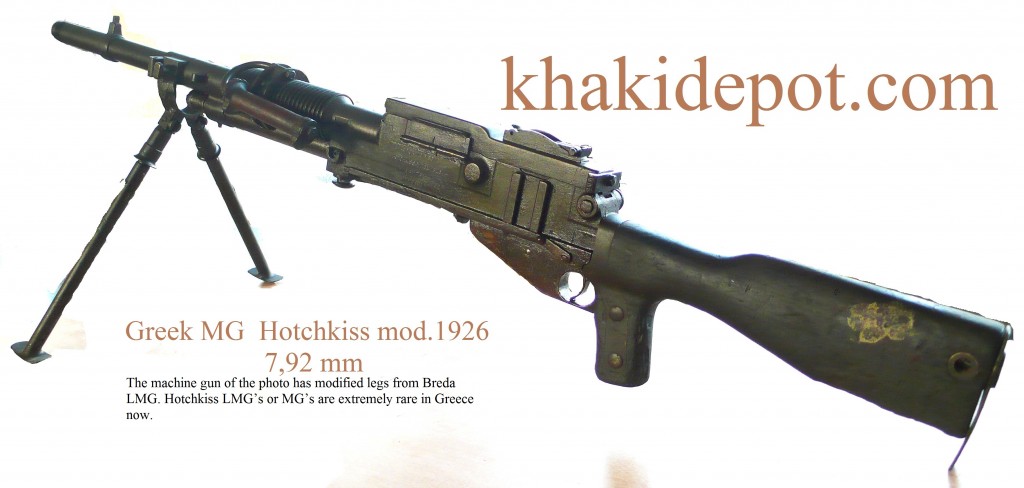
Mechanism
The 1922 Hotchkiss shares some features of the earlier Portative model, but not all. They both use a fairly large long-stroke gas piston located underneath the barrel to operate, but the Portative used a rotary locking mechanism, while the 1922 model has a bolt which tilts up to lock into the receiver. A swinging link connects it to the gas piston, pulling it down and out of battery when the gun is fired (something like the operating principle of the BAR).
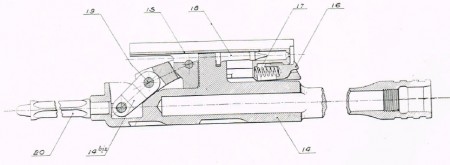
The trigger mechanism was full-auto only, with no setting for single shots. It did include a rate reducing mechanism, though, and a selector lever allowing the shooter to choose the fast or slow rate of fire. The wheel in the diagram below rotates against a spring, and acts to reduce the cyclic rate when engaged.
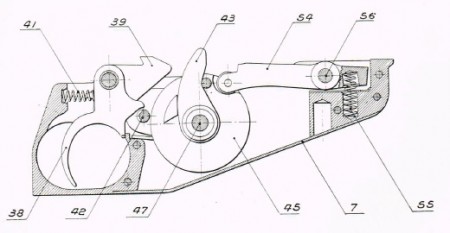
Manuals
We have a French manual for the strip-fed version of the M1922, as well as a few other documents pertaining to the gun:
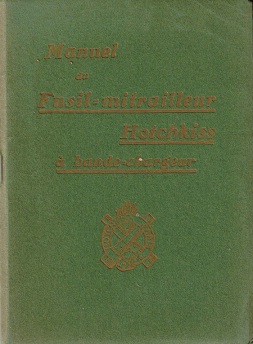
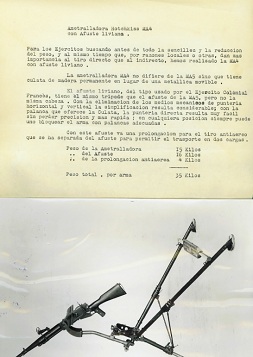
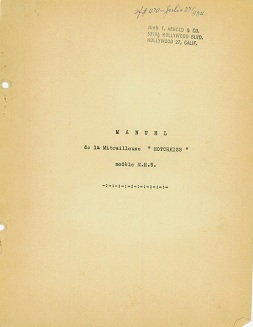
Additional Photos
Here are photos of two other Turkish M1922 guns that were deactivated and sold by Armas Izzara (I downloaded copies of the photos, and if the links do dead I’ll upload them here myself):


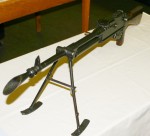





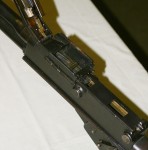




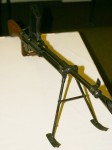
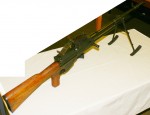
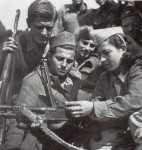


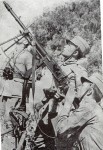

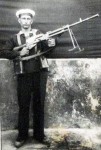
Hello,
I thought that you might be interested in this Rare Brazilian Portative Hotchkiss Machine Gun 7mm for sale on gun broker.
here is the link http://www.gunbroker.com/Auction/ViewItem.aspx?Item=485472742#PIC
Ben.
The Spanish Nationalists produced an improved version of the M1922 as the M1938. A saw one at the Es Castell Military Mueseum, Port Mahon, Minorca
Good afternoon, Mr. McCollum.
May I ask you, if the machine gun in the tripod is a MA5 or the heavy barrel version MH5? The gun was chambered for the 7.65×54 cartridge, and was used by the peruvians during the brief 1941 war against Ecuador.
[IMG]http://i68.tinypic.com/30241zr.jpg[/IMG]
Thanks and cheers.
Ian, I have come across two Turkish MDLE 1922 guns in 7.9mm over a ten year period here in Afghanistan. Trying to acquire the second one I just ran across. It still has the forward pistol grip and bipod. No feed strips that I can find. Do have a small amount of Turkish 7.9mm ammo too.
Came across a third one this week. It also has the forward pistol grip and bipod. Charging handle attached unlike the first one I came across in 09′
hello ,
whatwasthe overall length of the weapon pls.
andy